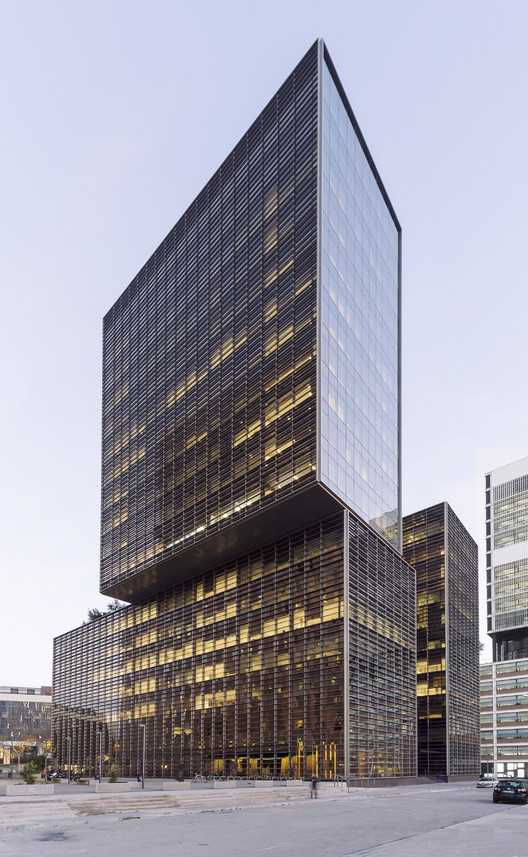
-
Architects: GCA Architects
- Area: 28000 m²
- Year: 2017
-
Photographs:Rafael Vargas
-
Manufacturers: Andreu World, Fritz Hansen, Viccarbe, nanimarquina, Cotlin, INCLASS, Living Divani, Meridiani, Pedrali, Roche Bobois, Roshults, Santa & Cole, Tisettanta, Vitra

Text description provided by the architects. From the outset, the concept of a continuous façade along the New Avenida Diagonal, stretching from plaça de les Glories to Forum, was always at the forefront of the urban planner’s vision. This façade was to be composed by buildings offering an iconic counterpoint, leading up as a gateway to the 21st century Poblenou neighborhood.

Located in Barcelona’s Campus Audiovisual 22@ business section and designed as a corporate headquarters, this building by GCA Architects rises as a pure and minimalist design, responding to the unique necessity of the place, as a building that interacts with the street. With a capacity of more than 1,000 people, the functional programme is divided into two towers of 11 and 18 floors respectively, reaching 72m high.

The towers are connected by the three-story glass entrance, lit by natural light through extra clear glass and a direct view from either entrance. The main entrance also accommodates the reception desk and other common amenities in this space of about 11x26m. The glass perimeter of the roof allows for the natural flow of light and the central skylights also act as means of extraction in the case of emergency.


The entrances consist of rounded doors with sliding entrances on either side marked with a glass awning. Indoors, the building houses restaurant with open kitchens, fitness center, a conference hall with a 200 people capacity, along with a car park with a 240 space capacity below ground, to name but a few of the features.

All in all, the building reaches 28.000 m2. Each tower has a compact core zone with staircases, restrooms and a group of 4 elevators with innovative systems to manage the smooth flow of people.

The shape of the Western tower creates a cantilever and allows the creation of a green terrace on the seventh floor at the same time. The façade is assembled by a modular construction system, which is finished with extruded aluminum slats and uprights providing both sunlight filtering and interior privacy, further reinforced by a highly reflective technological glass surface with the bottom third in opaque and visibility through the top two third.

The effect is a homogenous second skin that envelopes the building like a protective layer. Beyond the seventh floor, once the interior privacy is ensured, this skin fades out, offering a clearer view of the city and the sea. The building structure is made up of a heavy concrete core containing the restrooms, staircases, and elevators; and a metallic framework for the cantilever, which balances the structural load and helps to reduce the height of the slab.

For the structure construction, it was used as an ascending-descending system, which allows building from the ground level down and upwards simultaneously, shortening the construction time. To achieve this, the steel columns were driven directly into the piles during the construction of the foundation, playing a part on the corresponding final structure steel frame once excavation and concrete works are finished.

High-quality materials such as oak wood and modular furniture have been used in the interior design and a dividing system that allows for a more flexible spacing scheme. There are private rooms and offices as well as open office work areas. Regarding functionalities, there is a waste room on the ground floor, which is connected to a pneumatic waste collection system.


The air conditioning system is connected to the heat and cold urban distribution net, significantly reducing CO2 emission levels. The lighting system is powered by energy-efficient led technology lamps, including presence and light sensors system to get an additional energy saving. In terms of water consumption, restrooms are fitted with double-flushed technology and low water flow taps as well as electronic sensor control in order to save a considerable amount of water.


GCA Architects building has been conceived according to the rigorous sustainability standards of the US Green Building Council, aiming to obtain a LEED GOLD certification, which would allow up to a 30% of energy savings compared to other traditional high-rise buildings.













































